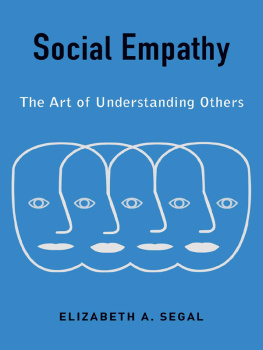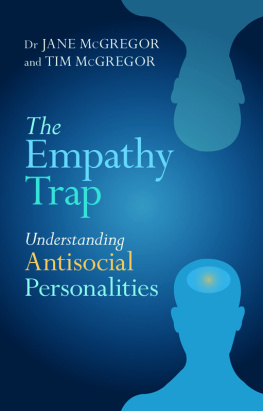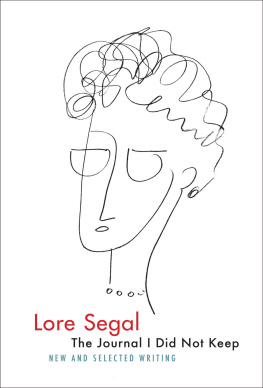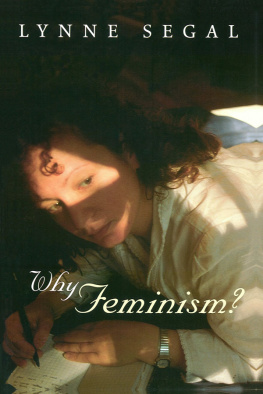Table of Contents
Social Empathy
SOCIAL EMPATHY
THE ART OF UNDERSTANDING OTHERS
Elizabeth A. Segal
Columbia University Press
New York
Columbia University Press
Publishers Since 1893
New York Chichester, West Sussex
cup.columbia.edu
Copyright 2018 Columbia University Press
All rights reserved
E-ISBN 978-0-231-54568-6
Library of Congress Cataloging-in-Publication Data
Names: Segal, Elizabeth A., author.
Title: Social empathy : the art of understanding others / Elizabeth A. Segal.
Description: New York : Columbia University Press, [2018] | Includes bibliographical references and index.
Identifiers: LCCN 2018020093 (print) | LCCN 2018022116 (e-book) | ISBN 9780231545686 (e-book) | ISBN 9780231184809 (hardback : alk. paper)
Subjects: LCSH: EmpathySocial aspects. | Compassion.
Classification: LCC BF575.E55 (e-book) | LCC BF575.E55 S443 2018 (print) | DDC 152.4/1dc23
LC record available at https://lccn.loc.gov/2018020093
A Columbia University Press E-book.
CUP would be pleased to hear about your reading experience with this e-book at .
Cover design and illustration: Mary Ann Smith
For my parents, of blessed memory, my guides to building a life with empathy, humility, and a commitment to justice
Contents
I NEVER PLANNED to study empathy. When I trained to be a social worker more than thirty-five years ago, I quickly discovered my passion was in what we call the macro side of practiceunderstanding communities and public policy. Empathy was for the clinicians and micro practitioners, which I was not. I was fascinated by the how and why behind government social programs. I had a million questions. Why do one in five children grow up in poverty in the richest country in the world? Why did it take one hundred years after the Civil War to pass civil rights legislation? Why are the indigenous people of this country, the first to live here, the poorest group among us? Why do we spend more per person on health care but have levels of health that are far below countries that spend much less? I loved going to my social welfare policy course to try and answer these questions. It was a passion that shaped my professional career. I went on to study political science, public policy, and urban sociology. I even spent a year working in Washington, DC. All these efforts were to help me better understand social public policies.
I became pretty proficient in that effort. I even wrote a textbook on social welfare policies and programs, now in its fourth edition. With all that knowledge, I still hit a snag when teaching about social public policies. I have been teaching for more than thirty years, and the course I have taught most frequently is about social welfare policies and programs. I have taught that course at all levels, from introductory students taking their first college class to graduate students studying to get their doctorate. My primary goals in that course are to help students understand why public policies look the way they do and to answer all those questions that had prompted me to pursue this line of study.
What makes this course special is that we ask what role we each take in the development of these public policies and in the programs that evolve from these policies. Our role as social workers includes a professional commitment to advance human rights. We are mandated to advocate for social, economic, and environmental justice. To do so requires stepping into the shoes of others, not just individually, but also into different social groups and communities to understand their unique experiences.
As much as I taught about being an active member of our community and the importance of seeing the world as others see it, I found some students who got it and other students who did not. Some students embraced seeing the world as others do, including the historical experiences of different groups and where they fit in our larger society. Others could not go there. They were comfortable trying to see an individuals perspective, but they could not consider an entire groups experiences. Both types of students were kind and caring people, most of whom were interested in or already committed to a career as a social worker. Why did some of my students feel strongly about the well-being of the larger society, interested in the needs of people who they did not even know, while others stayed away from that? Something was different. That question led me to study empathy and develop the concept of social empathy.
My first public professional mention of social empathy was in 2003 as part of a panel on poverty. I was fortunate to have two colleagues on that panel, Drs. Madelaine Adelman and Keith Kilty, who provided my first professional feedback on the concept. Keith was instrumental in helping me to get the idea published in the Journal of Poverty that we coedited at the time. Madelaine was and continues to be a wonderful sounding board and collaborator on developing what social empathy means and how to measure it among students. I am most grateful to Madelaine and Keith for their early critiques and encouragement.
I started a research sabbatical in 2008 with the goal of writing all about social empathy. I had begun to develop more fully the idea of social empathy with several published professional articles exploring the concept, but I didnt know much about interpersonal empathy. When I dove into the literature on empathy, I discovered it was almost entirely focused on individuals, and I became overwhelmed. I was not proficient in psychology or behavioral biology, so the literature was thick and obtuse to me. Luckily, I had a friend and colleague, Dr. Karen Gerdes, who was also on a research sabbatical. We had a plan to meet once a week for breakfast to check in and help each other stay on track with our research projects. Over one of our early breakfasts I shared with Karen my distress over the volume of literature on empathy and that most of it required a better understanding of psychology than I felt I had. Karen was much more proficient in that area, so I asked her if she would be kind enough to do a little reading and help me develop a plan to tackle all that was out there. Karen is one of the most generous and kind people I have ever met, so I knew that asking her would mean a yes. I also did not want to take her off course of her own studies, but I felt at a loss and really needed her guidance. I hoped taking a week away from her studies would not be too much of a burden. Karen agreed to see what was out there and promised to report back at our breakfast the next week. Only a few days had passed when Karen called me to tell me how excited she was from her foray into empathy. She had found a whole new area of research on empathy that was coming from neuroscientists, experts at decoding the intricacies of how our brains work. It was research on empathy and brain imaging in its earliest stages. Karen had already been focused on how we learn and was intrigued by brain science, so this new research was fascinating and inviting to her. Over our next breakfast we talked all about what Karen had found, and over pancakes we both altered our research plans. We decided to forge ahead together to better understand all the aspects of empathy, from psychology, biology, and neuroscience, integrating our perspectives as social workers who study how human beings behave in the larger social environment. We had no idea where it would take us but were both excited to head off in this new direction.


















